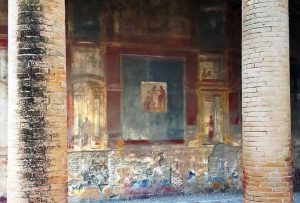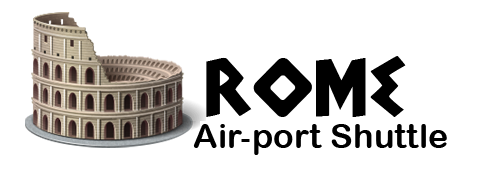
Day Trip Rome to Pompeii
The tour will begin with your private driver collecting you from your hotel in Rome, and will explore the city with your personal guide
This day trip from Rome to Pompeii will start in the morning with your private driver who will pick you up from your hotel/apartment in Rome with a luxury sedan or minivan.
Your driver is an English speaking and during the 3 hours travel from Rome can introduce you Pompeii and other nice sightseeing in the area. Once in Pompeii, the driver will dropp off you at the main entrance of Pompeii ruins, you will have enough time for a great visit to the ancient town.
Upon your arrival in Pompeii you will meet your officially authorized private tour guide who has a degree in archeology or art history. The knowledge of a guide is essential given the complexity of this vast archaeological site. Your guide will take you through the ruins of Pompeii for approximately 2:30-3:00 hours, visiting the most interesting places and telling the story of this Roman city that was buried by ash during the volcanic eruption of Mount Vesuvius in 79 AD and which remained covered until excavations began in the 18th century.
You will walk along the paved streets where two thousand years ago the inhabitants of this city used to walk, you will see the shops where they did their own trade, enter the small houses of the majority of the population and the luxurious villas of the rich, where you can admire the frescoes that arrived with intense colors until our time.
Forum and adjacent temples (Region VII)
The Forum was the center of life in the city and where the main administration buildings, markets and temples, such as those of Apollo and Jupiter were located.
Forum Baths (Region VII)
The Baths, which are located behind the Temple of Jupiter, date back to 80 BC. There are several beautifully decorated rooms, which had been restored a few years before the eruption, due to an earthquake that occurred in 62 AD.
Lupanar (Region VII)
This is the ancient brothel of Pompeii. At that time, prostitutes were slaves from Greece or Eastern countries. The building has two floors and still has some small paintings with erotic themes.
Casa de Sirico and Termas Stabiane
The huge house and the Baths occupy the same block on via Stabiana. The house dates back to the 1st century AD and was being renovated at the time of the eruption. There you will find preserved concrete human figures.
The Stabiane baths are some of the oldest in the Roman world, dating back to the 2nd century BC. The state of conservation of the building is impressive.
House of Marcus Lucretius (Region IV)
It is a junction of two independent houses. It has paintings of mythological beings, a large atrium and a small garden with a fountain and sculptures.
House of the Vettii (Region VI)
This is one of the richest and most famous houses in Pompeii. In fact, there is the god of Prosperity, Priapus, painted right next to the door, symbolizing the wealth of the owners, the brothers Aulus Vettius Restitutus and Aulus Vettius Conviva. The house is covered in paintings and decorations that are still very well preserved.
House of the Golden Cupids (Region VI)
This house has an elegant, oval-shaped garden with columns around it. The large hall has paintings of mythological figures and a mosaic floor. There is a chapel dedicated to Egyptian gods. The name of the house is attributed to two cupids, engraved in golden medallions in the portico. The house belonged to a relative of Emperor Nero’s second wife.
Village of Mysteries (Region VI)
The Village is outside the ancient walls of Pompeii. Large complex also had an area for wine production. Building dates back to the 2nd century BC, but with renovations from 80 to 70 BC. The name comes from a hall in the house, covered with frescoes on three walls and showing a mysterious rite with the God Dionysus and his wife Ariadne.
House of the Faun (Region VI)
One of the largest houses in Pompeii, occupying an entire block, measuring 3000 m², and with a layout from the 2nd century BC. The house is especially famous for a statue of Faun in a fountain in the atrium and for the mosaics depicting the battle between Alexander the Great, and Darius, the king of Persia. The original sculpture and mosaics are in the Naples Archaeological Museum.
Championnet House (Region VIII)
A sumptuous building in Pompeii, with sea views and at least four floors. It has several colorful mosaics on the floor and a thermal system that was already active in the 1st century BC.
Basilica (Region VIII)
The Basilica was part of the Forum and was one of its richest buildings, measuring 1500 m². It was used to do business and was where the judiciary at the time operated. The Basilica of Pompeii dates back to 130 BC and is one of the oldest in the entire Roman world.
House of Geometric Mosaics (Region VIII)
Another giant house in Pompeii, with more than 60 rooms and an area of 3 thousand square meters. It has views of the sea, two floors and several terraces. And of course, as the name says, several examples of geometric mosaics.
Temple of Isis (Region VIII)
The Temple of Isis was one of the first to be discovered by excavations, in 1764. The fact that they found the place with the decorations almost intact contributed to the decision to publicize Pompeii to the world. Worship of the Egyptian goddess Isis spread across the Mediterranean in the 3rd century BC and was popular among the lower classes of Pompeii. All the statues and furniture from the temple are today in the Archaeological Museum.
Grand Theatre, Odeon and Quadriportic (Region VIII)
The Great Theater was built taking advantage of the natural slope of a hill, in the middle of the 2nd century BC. Comedies and tragedies of the Greco-Roman tradition were performed in the space. This was also the first major public building to be excavated and freed from eruption deposits in the 18th century.
The Little Theater, or Odeon, is right next door. It was built a few years later – an inscription reveals the exact year: 79 BC. The smaller theater was used for musical performances.
To top it off, behind the stage of the large theater is an area surrounded by 74 Doric columns, which served as a foyer for spectators between performances. Probably after the earthquake of 62 AD, the space changed its function, becoming the place where the gladiators’ tents were located. In the archaeological museum in Naples you can find weapons used in battles. Many victims were also found at this site: 4 skeletons of slaves, 18 of free men and that of a woman with a rich collection of jewelry.
Casa do Criptoporticos (Region I)
A two-story house, which changed owners several times, as revealed by several interior renovations. The cryptoportico that gives the house its name is decorated with frescoes of satyrs and on the friezes there are scenes from the Trojan War. There is one of the few documented private baths in Pompeii.
House of Sitarists (Region I)
Another example of a huge house in Pompeii, measuring 2700 m², thanks to a process of incorporating several properties. The residence has two atriums and three interior courtyards surrounded by columns, one of them with a swimming pool, where there was a sculpture of a wild boar being attacked by two dogs, a lion, a deer and a snake, surrounded by fountains.
Menander’s House (Region I)
Another house of a very rich family close to Emperor Nero. In this one, in the atrium there are frescoes with scenes from the Iliad and the Odyssey. Boxes with silver pieces that served as banquet apparatus were found there.
Garden of the Fugitives (Region I)
This site had been transformed into a winery in the years preceding the eruption. 13 victims were found there, who were probably trying to escape through the Nocera Gate when they were hit by the fatal pyroclastic flow. The molds of the 13 people are there, at the back of the garden.
Amphitheater and Grand Palaestra (Region II)
The Grande Palaestra is an open square, surrounded by porticos. There are molds of the roots of the centuries-old trees that surrounded the hall. The place was built at the beginning of the 1st century AD as a training center for young people.
Right next door is the impressive amphitheater, one of the oldest Roman ones. Built in 70 BC, it has capacity for up to 20 thousand spectators, people who came not only from Pompeii, but also from neighboring cities.
House of Venus in a Shell (Region II)
The house, from the 1st century BC, is famous for its frescoes, especially the one that gives the property its name: the goddess Venus, naked, wearing only a tiara and jewelry, lying on a large shell.
********************************************************************************************************
BOOKING – DAY TRIP ROME TO POMPEII
Step 1: Request a quote
Submit your service request by filling out the quote form below or via whatsapp
Step 2: Get the quote
Once the request has been submitted, you will receive our quote in a few minutes or a few hours.
Step 3: Confirmation
If you are interested in the quote you receive, you can confirm it by simply replying to the email or message.
Step 4: Completing the operation
Wait for our confirmation of booking completion, service summary, details, and driver contact.
*********************************************************************************************
Find exciting holiday ideas for this years in Italy
Travel Tips for Rome
Vatican Tours – Visit St. Peter’s Basilica and the Sistine Chapel
Tours of Rome Italy – Religious Tourist Attractions in Eternal City
Travel Tips for Amalfi Coast
Sorrento Tours – Daily Excursions & Private Driver Car
Holidays to Positano – Ravello and Atrani along the Amalfi Coast in Italy
Travel Tips for Tuscany
Tips How to Find the Best Accommodation and Hotels in Florence Italy
Best of Tuscany Tour – Arezzo and Cortona Discovering the Etruscans








